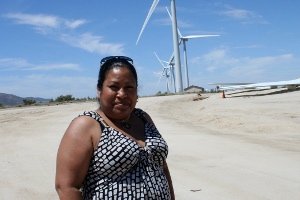
“Tribes are not really part of the economic dialogue of this country.”
That’s Mike Connolly – a former tribal council member for the Campo Kumeyaay Nation – in response to my question about why his Southern California desert tribe hosts the only utility-scale renewable energy project on tribal land in the country.
Tribal renewables seem like a no-brainer: Indian land makes up five percent of the total area of the US and according to one federal government estimate, ten percent of the country’s total renewable energy potential, such as solar or wind power, is on tribal land.
No place needs the development more than Indian reservations, where unemployment often hits 60-70 percent. Strikingly, the tribes with the most renewable potential are often those that have benefited the least from casino profits, because they are so remote. Many of these tribes don’t even have electricity – and yet they have a tremendous capacity to produce it, in a clean form that could help California meet its ambitious renewable energy goals.
But, says Connolly, tribes face an unequal playing field. First and foremost: As sovereign nations –- quasi-independent governments — they can’t access federal renewable energy tax credits. These credits can shave millions off the cost of a renewables project, but are only available to tax-paying entities, such as private companies.
Once a tribe partners with a private company, along comes another obstacle: Local and state governments can assess tax on any project undertaken by a non-tribal investor, even if the project is on sovereign, tribal land. This keeps tribes from levying their own taxes, since that would amount to double-taxation and likely kill the deal.
Tribes also cite a morass of red tape that, they say, hampers any proposed development on Indian land, thanks to the complicated relationship between tribes and the federal agency designated to oversee them, the Bureau of Indian Affairs.
The Indian Energy Promotion and Parity Act of 2010 would go a long way toward addressing these and other problems. It would create incentives to investors developing on private land, ease the permitting process, and open up the tax credits to tribes. It would also require that tribes be included in conversations over where transmission lines are placed.
As this story posts, the Indian Energy bill is due to be introduced into Congress at any time. But when that happens, it’ll land on a tall stack of energy-related proposals, all of it at the mercy of a Congress that seems unwilling to act on energy, or climate.
Listen to Renewables on Indian Land radio report online.
